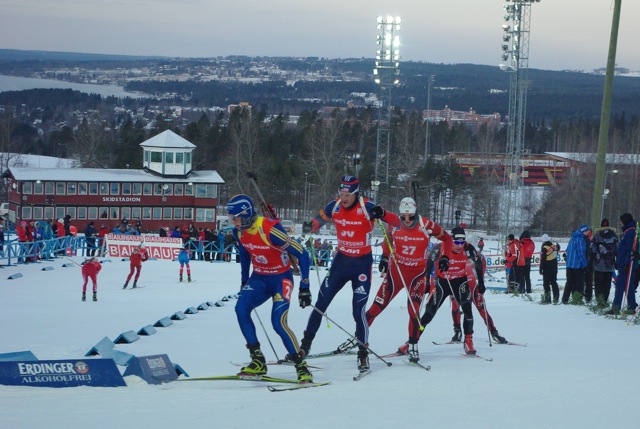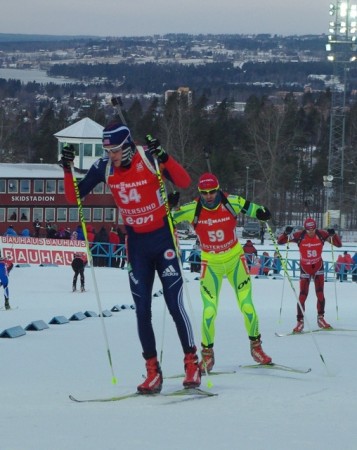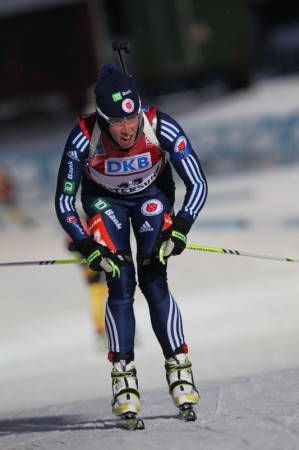
ÖSTERSUND, Sweden – For two guys who were aiming for the medals last year and ended 2012 ranked in the top 20 of the World Cup, the biathlon season doesn’t, by outward appearance, seem to be off to a great start.
Neither Lowell Bailey nor Tim Burke made a strong impression in Wednesday’s 20 k individual (they placed in the mid-30’s), then Burke skied from 18th to 15th in today’s pursuit and Bailey from 30th to 21st. Not bad results, but a far cry from last year when Bailey electrified the U.S. biathlon community by placing ninth in the individual and fifth in the sprint.
This year, though, is different – and the two men know it.
“For Tim and myself especially, we both kind of planned on training right up to the season, and getting the most out of our training season so that we can hopefully progress through the winter,” Bailey told FasterSkier after the pursuit. “So that was my plan, and so far I’m pretty happy with that and looking forward to Hochfilzen.”
Burke agreed.
“I think it was pretty positive considering that leading up we really did zero prep,” he said. “So we’re pretty happy.”
The rest of the men’s team wasn’t so lucky; Leif Nordgren’s 54th place showing in the sprint was the best of the rest, and he slipped to 59th in the 12.5 k pursuit after a rough day on the range in which he missed eight targets. Jay Hakkinen’s best result was 63rd in the individual, while Russell Currier placed 89th and 80th.
But the team seemed positive, and cited a few other circumstances they had overcome. Burke, for one, struggled mightily with the cold in today’s race.
“I was basically curled up in a ball for fifteen minutes afterwards,” he said in the warmth and comfort of his cabin (FasterSkier thought it would be cruel to stop such a visibly frozen athlete in the mixed zone). “It was tough. It wasn’t even that cold, compared to some of the races we did last year, but I don’t know if my body wasn’t used to it or what – I had a hard time!”
That certainly contributed to Burke’s performance on the trails and the range; he missed two shots, and skied the 21st-fastest time. Again, actually good signs – but after competing at the highest level for so many years, Burke usually expects better. In this race last year, for example, he had the fourth-fasted ski time. This time around, not only was he not at peak recovery and fitness, but he had some extra challenges.

“Basically, I felt like I was just never warmed up on the course,” he said. “My hands, and feet, just to get them moving. And then on the range, I haven’t seen the breakdown yet, but I had a really hard time just loading the rifle and switching clips. And in prone, to get the sling on, I kept missing. I couldn’t get it on. So I took my time.”
The competition analysis confirmed his suspicions: Burke is never the fastest shooter in the field, but he doesn’t usually lose 53 seconds just on the mat. In his toughest stage today, Burke was 18 seconds behind the fastest shooters. Cold fingers will do that – and two penalties are far from the worst outcome of such a day.
“Considering that – there’s actually a pattern, that when my hands are really cold I shoot well,” he said. “Really slowly, but well. So it was okay. I was happy with the shooting.”
Bailey had one slow stage of his own, but in general shot faster than Burke. He, on the other hand, had gotten stuck on the range in the sprint, when the wind was gusting through the stadium and he couldn’t find a good shot.
“I had the same thing going on in the sprint,” Bailey said. “I had 30 seconds extra of range time that normally I wouldn’t have. But I just had to sit and wait, or stand and wait as it were.”
Bailey was mainly happy that his ski times seemed to be improving as his body began to absorb the training load from the fall. In the pursuit, he skied the 18th-best time, more on par with his performances last year.
“Really, I’m pretty happy with the race,” he said. “I executed everything that I wanted to as far as my game plan goes, and there was just one stage unfortunately where I had two missed shots. That set me back a little bit, but it was good to be back up fighting for a top ten. That’s where I want to be. Ski speed was higher today, so I’m happy that it seemed to get faster through the week… and I’m satisfied with the result.”
The women’s team was left less satisfied, with Susan Dunklee the only American to make the 10 k pursuit. Annelies Cook had a strong individual race, placing 46th and being in an even better position before missing two shots on the final stage, but Sara Studebaker and Lanny Barnes were disappointed; neither made the top 70 in either the individual or the sprint.
And while Dunklee was glad to be in the pursuit, she was generally ambivalent about her results this weekend. She had placed 45th in the sprint before moving up to 39th in the pursuit, despite missing five shots.

“I definitely wasn’t feeling as good on skis today as yesterday,” she told FasterSkier at the finish. “There is a section of no-mans-land after the range where it’s all flat and V2, and I was losing so much time. I couldn’t find that faster gear. The range wasn’t terrible, no really bad stages, but no really good stages either.”
Like the men, however, she was looking at the big picture and not too worried about results here in the first week of competition.
“It’s a long season,” Dunklee said. “We have about 30 races over the course of the season, so there’s plenty of time. A lot of these other teams have been racing over the last several weeks, and we just got going at this World Cup. So it’s kind of warming up and easing into things.”
Part of the reason that the team hasn’t had many race starts, she said, was that they are from a different continent. While the Americans fly to Europe relatively early – more than a week before the Canadians, for instance – they aren’t there early enough to do all of the prep races, and hesitate to come earlier because they already spend so much of their winter away from home.
For Dunklee in particular, the pursuit was an exciting improvement because she landed in the points, even if she wasn’t happy with any of the individual components. It’s getting more towards the point where she finished last season, placing fifth at World Championships and notching several top-tens in the final weekend of World Cup racing.
“I think coming into these races, I was so confident all summer that I thought I could just dive in where I left off,” she said. “I’m kind of realizing that I just need to go back to being Susan – having fun racing, and just reacting to whatever is going on. I do best when I’m having fun, so being more relaxed about it. I’m happy that I figured that out the last few days.”
Next weekend, she hopes, she’ll be able to put the changes into action. The Hochfilzen courses are good for her, with more climbing and less “no-mans-land” flat sections, and the weekend will boast one more feature that she is sure will jump start the U.S. women’s team.
“I’m really excited because they have a relay there,” Dunklee said. “The whole group is ready to go. Those are some of the most fun races. People are excited about it and we all know that we can do better, and we’re going to be there. It’s just a matter of time.”
Burke and Bailey were positive about the relay too.
“I think we’ve got five solid guys, and it looks like Lief was feeling a little better on the skis as the week progressed,” Bailey reported. “Russell will be well-rested and ready to go. So we’ll see.”
“So much of the relay comes down to shooting and those guys haven’t been feeling the greatest this week, but if they get in a good pack in the relay, I’m sure, they’ll hang,” Burke agreed. “If we have good shooting, we’ll be right in the mix.”
Bailey: “It all comes down to shooting.”
International race reports: men / women

Chelsea Little
Chelsea Little is FasterSkier's Editor-At-Large. A former racer at Ford Sayre, Dartmouth College and the Craftsbury Green Racing Project, she is a PhD candidate in aquatic ecology in the @Altermatt_lab at Eawag, the Swiss Federal Institute of Aquatic Science and Technology in Zurich, Switzerland. You can follow her on twitter @ChelskiLittle.



